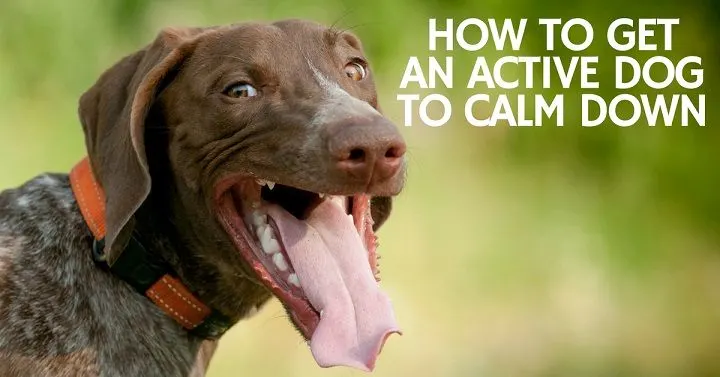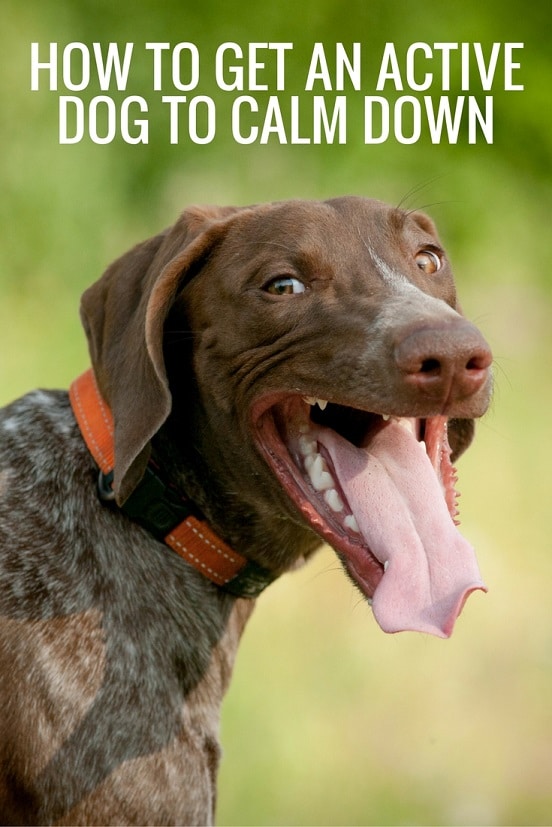How to get an active dog to calm down
Most of us have had active dogs at some point. Getting them calm down is not as easy as “just give them more exercise.” That is only part of the equation. I’ll share my tips below, and then I’d love to hear your ideas on how to get an active dog to calm down.
Tips to get an active dog to calm down
1. Lots of walking throughout the week.
It’s not about one long walk on Friday. The dog will be wild again by Saturday morning. It’s about planning a long walk every single day. If your dog is hyper, I recommend a 60-minute walk with him every morning and another 20-minute walk in the evening whenever possible. You will miss some days, but shoot for longer walks, more often. Running with a dog is even better. If you don’t have the time to exercise your dog, consider hiring someone.

2. Work your dog’s mind.
A mental workout can do more to tire out some dogs than a physical workout. Look for ways to mentally challenge your dog every single day for at least five minutes – preferably three or four five-minute sessions throughout the day. You can work your dog’s mind by:
- visiting new places
- walking with other dogs
- working on obedience training
- feeding your dog from puzzle-type toys instead of bowls
- having him wear a dog backpack on walks
3. Sign up for an obedience class.
This is an easy way to work your dog’s mind while teaching him to be calm around other dogs. My own dog will be tired after a walk, but after an obedience class he comes home and crashes.
4. Teach your dog to be comfortable doing nothing.
If you have an over excited dog, you’re probably always looking for ways to keep him more active. Really, one of the best things to teach him is how to lie around and do nothing. There are different ways you can do this such as teaching the dog to lie quietly in a kennel with a chew toy or tethering the dog across the room and encouraging him to lie on his bed.
It’s also important for every dog to learn how to stay on command for long periods. It’s reasonable for every dog to learn to stay on command and remain staying for up to a half-hour in the house with no distractions. You’ll have to start with just 30 seconds or so, and build from there. Dogs with a higher level of obedience will also have more self-control, allowing them to be more relaxed while doing nothing.
5. Time to run off leash.
Most dogs benefit from a good off-leash run at least a few times per week. This might actually make your dog seem more energetic because of the initial excitement, but overall it should help him get rid of pent-up energy. Depending on your dog, you may be able to just let him run off leash in the country or at a dog park. If neither of these are an option, the next best thing is to allow the dog to run on a 50-foot rope. When you use a long rope, you may be able to allow the dog to drag the rope around, or you may have to hold onto the rope (where gloves!).
What are some tips you use to get an active dog to calm down?


Jean Patterson
Sunday 15th of January 2017
Great article, great comments... We have four dogs all ages from 13 years to 3 years and the ones that can go for a bike ride once a week. They all go to dog group twice a week. Tons of obedience training along with impulse control training, and learning new tricks to keep them sharp. And we get to walk every day. The younger two play ball like crazy. Something as simple as teach to wear a muzzle can tucker mine out. It doesn't take much when you work the mind. I think of it like when we start a new job, even though we know how to do the job, we still have to learn new people, where things are put, and new environments, makes me very tired at the end of the day.
Lindsay Stordahl
Sunday 15th of January 2017
Yes, so true
Barbara Rivers
Friday 23rd of September 2016
I swear by our doggie backpacks - they're such a great combination of a physical and mental workout. My pups go for daily backpack walks during fall, winter, and spring. Unfortunately, summer time is just too hot & humid to add the pack to our walks, but we make up with games inside the house (hide & seek, running up and downstairs, practicing tricks).
I also LOVE taking the pups wherever I can - dog friendly places such as PetCo, Tractor Supply and dog-friendly restaurants with an outdoor patio make for great socialization experiences.
Now that we have a fenced in yard I rarely use our 50 ft rope anymore, but it got a lot of use when we lived in apartments. It was a wonderful way to let Buzz retrieve his frisbee/ball - and yes, I learned the hard way that one should wear gloves when handling the rope!!
Nolindr
Monday 29th of July 2013
I had a flat haired retriever that used to love to swim, couldn't get him out of the water. We would go to the nearby Lagoon when the tide was going out, or coming in, and on his long lead would swim against the currant. I would throw rocks or sticks ahead of him to keep up interest. (If I didn't keep his leash on he would swim to Japan hahaha) Also on a lead, swimming at the lake around the long dock - all up one side, around and down the other, then turn around and keep going up one side and down the other. Tuckered him out for the rest of the day, and was always clean :)
Rachel @ My Two Pitties
Friday 28th of June 2013
Good tips! Kaya is an active, excitable dog. Apart from regular off leash exercise, I quick calm down exercise I do with her is something I call "Kaya's aerobics" in which I ask her to do a bunch of tricks quickly in a row. She does sit, down, spin in either direction, wave and jump in the air. A few minutes of this and she is ready to pass out on her side. Another one, especially when people come over, is just to have her down stay until she is calm and ask people to ignore her.
Lindsay Stordahl
Friday 28th of June 2013
I think those are some great suggestions for others. I will try the "aerobics" with Ace! :)
Pipa
Thursday 27th of June 2013
A great article! Funny you wrote this now as recently this has been a big topic in my dog people circles! Someone in my foster group is fostering an ex-hunting dog and getting him to turn off that drive and calm down is quite the task.
I do a most of those suggestions (Phew!), but the biggest gain for me recently is that he's gotten a lot better off the lead. He is a very stubborn dog and recall was not his strong point, but we worked SO hard on it recently so I could feel comfortable with him off lead in select places. Now that he gets a sprint out of his system every day I've noticed a huge difference. A walk just didn't cut it. We used the long lead for a good while and that really helped. A few rope burns later I might add... People tell me that I'm spoiling my dog to consider him and go out of my way like this, but I just tell them that he's trained me to do it! If I don't, something will be destroyed when I get home! :P (said only half jokingly haha)
Lindsay Stordahl
Thursday 27th of June 2013
Great work on the off-leash skills. I am so luck that my dog is a big baby and always stays close on his own. I didn't have to do anything to train him to stick close, and I didn't have to do much to teach him the recall either.